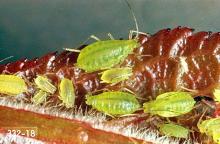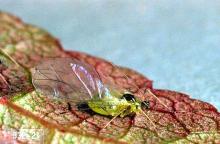Hop aphid (Phorodon humuli)
Leafcurl plum aphid (Brachycaudus helichrysi)
Description, biology and damage The aphids tend to be small (.0625 to 0.125 inch in length), oval- to pear-shaped, soft-bodied insects with piercing-sucking mouthparts. Hop aphids are soft-bodied oval insects with pale yellow green with coalescing stripes that may form patches. Their feeding causes leaves to roll. Typically, the aphids are on the underside of plum leaves, or inside the rolled leaves. Heavily infested plants may drop leaves, resulting in severe defoliation. The leafcurl plum aphid is typically pale green to yellow in color during the summer and darker green to brown later in the year. Feeding by the leafcurl plum aphid causes severe curling of leaves on plum.
Biology and life history The aphid overwinters as eggs in crevices and twigs on plum, prune, or cherry. The eggs hatch near budbreak and the nymphs feed on unopened buds and the underside of the leaves. The leaves curl and protect the aphid as they feed. After two to three generations, winged forms are produced that migrate to summer hosts, which include weeds, ornamental plants, and vegetables. Following several more generations, the winged forms migrate back in the fall to the fruit trees to mate and lay the overwintering eggs. Some aphids remain on the winter host all year round.
For biology, life history, monitoring and management
See "Aphid" in:
Management-chemical control
See Table 1 in:



